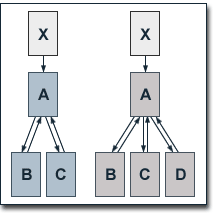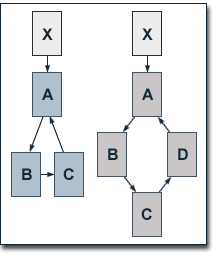|
|
 |
The Effect of the Number of Pages |
 |
|
 |
Since the accumulated PageRank of all
pages of the web equals the total number of web pages, it
follows directly that an additional web page increases the
added up PageRank for all pages of the web by one. But far
more interesting than the effect on the added up PageRank of
the web is the impact of additional pages on the PageRank of
actual websites.
 To illustrate the effects of addional web pages, we
take a look at a hierachically structured web site consisting
of three pages A, B and C, which are joined by an additional
page D on the hierarchically lower level of the site. The site
has no outbound links. A link from page X which has no other
outbound links and a PageRank of 10 points to page A. At a
damping factor d of 0.75, the equations for the single pages'
PageRank values before adding page D are given by To illustrate the effects of addional web pages, we
take a look at a hierachically structured web site consisting
of three pages A, B and C, which are joined by an additional
page D on the hierarchically lower level of the site. The site
has no outbound links. A link from page X which has no other
outbound links and a PageRank of 10 points to page A. At a
damping factor d of 0.75, the equations for the single pages'
PageRank values before adding page D are given by
PR(A) = 0.25 + 0.75 (10 + PR(B) + PR(C))
PR(B) =
PR(C) = 0.25 + 0.75 (PR(A) / 2)
Solving the equations
gives us the follwing PageRank values:
PR(A) =
260/14
PR(B) = 101/14
PR(C) = 101/14
After
adding page D, the equations for the pages' PageRank values
are given by
PR(A) = 0.25 + 0.75 (10 + PR(B) + PR(C) +
PR(D))
PR(B) = PR(C) = PR(D) = 0.25 + 0.75 (PR(A) / 3)
Solving these equations gives us the follwing PageRank
values:
PR(A) = 266/14
PR(B) = 70/14
PR(C) =
70/14
PR(D) = 70/14
As to be expected since our
example site has no outbound links, after adding page D, the
accumulated PageRank of all pages increases by one from 33 to
34. Further, the PageRank of page A rises marginally. In
contrast, the PageRank of pages B and C depletes
substantially. |
|
|
The Reduction of PageRank by Additional
Pages
|
|
|
|
By adding pages to a hierarchically structured
websites, the consequences for the already existing pages are
nonuniform. The consequences for websites with a different
structure shall be shown by another example.
 We take a look at a website
constisting of three pages A, B and C which are linked to each
other in circle. The pages are then joined by page D which
fits into the circular linking structure. The regarded site
has no outbound links. Again, a link from page X which has no
other outbound links and a PageRank of 10 points to page A. At
a damping factor d of 0.75, the equations for the single
pages' PageRank values before adding page D are given by We take a look at a website
constisting of three pages A, B and C which are linked to each
other in circle. The pages are then joined by page D which
fits into the circular linking structure. The regarded site
has no outbound links. Again, a link from page X which has no
other outbound links and a PageRank of 10 points to page A. At
a damping factor d of 0.75, the equations for the single
pages' PageRank values before adding page D are given by
PR(A) = 0.25 + 0.75 (10 + PR(C))
PR(B) = 0.25 +
0.75 × PR(A)
PR(C) = 0.25 + 0.75 × PR(B)
Solving
the equations gives us the follwing PageRank values:
PR(A) = 517/37 = 13.97
PR(B) = 397/37 =
10.73
PR(C) = 307/37 = 8.30
After adding page D,
the equations for the pages' PageRank values are given by
PR(A) = 0.25 + 0.75 (10 + PR(D))
PR(B) = 0.25 +
0.75 × PR(A)
PR(C) = 0.25 + 0.75 × PR(B)
PR(D) = 0.25 +
0.75 × PR(C)
Solving these equations gives us the
follwing PageRank values:
PR(A) = 419/35 =
11.97
PR(B) = 323/35 = 9.23
PR(C) = 251/35 =
7.17
PR(D) = 197/35 = 5.63
Again, after adding page
D, the accumulated PageRank of all pages increases by one from
33 to 34. But now, any of the pages which already existed
before page D was added lose PageRank. The more uniform
PageRank is distributed by the links within a site, the more
likely will this effect occur.
Since adding pages to a
site often reduces PageRank for already existing pages, it
becomes obvious that the PageRank algorithm tends to privilege
smaller web sites. Indeed, bigger web sites can counterbalance
this effect by being more attractive for other webmasters to
link to them, simply because they have more content.
None the less, it is also possible to increase the
PageRank of existing pages by additional pages. Therefore, it
has to be considered that as few PageRank as possible is
distributed to these additional pages. |
|
|
|
|
|
|
|
|
|
|
|
|
|
|
PageRank and Google are trademarks of Google Inc.,
Mountain View CA, USA.
PageRank is protected by US Patent
6,285,999.
The content of this document may be
reproduced on the web provided that a copyright notice is
included and that there is a straight HTML hyperlink to the
corresponding page at pr.efactory.de in direct
context. |
|
|
|
| |
|